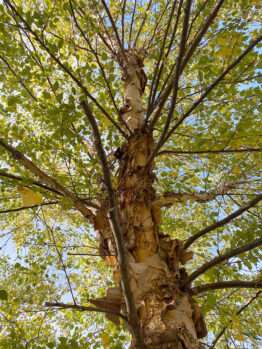River Birch
Researched by Georgina Vasquez-Guzman
 Species: Betula nigra
Species: Betula nigra
Common name: River Birch
Family: Betulaceae (Birch Family)
Clade: Angiosperms (flowering seed plants)
Coordinates: 39.70726457, -75.12017447
A tag using this number is placed near the tree.
Birch trees are members of the Betulaceae (or birch) family, a group of flowering trees and shrubs. The river birch is native to the eastern regions of the United States, with a range extending from northern Florida to southern New York and inland as far as Texas and Iowa. Their common name reflects that these trees enjoy growing near swamps and rivers with plentiful water.
Betula nigra, the Latin name of the river birch, refers to the darker color of its bark when the tree is mature. River birch trees are known for their peeling or exfoliating bark, which occurs naturally in this species. These trees can grow with single trunks, but often, they are multi-stemmed and grow in clumped arrangements.
The river birch leaves are simple with pinnate venation and doubly serrated edges. They are arranged in an alternating pattern on the branches. Deciduous, the leaves will turn a vibrant or brownish-yellow color and drop each fall before regrowing the following spring. Read More
Campus Species Map
Researcher’s Biography

Georgina Vasquez-Guzman
Georgina Vasquez-Guzman earned her Bachelor of Science in Biological Sciences in 2023.
Suggested Citation:
Vasquez-Guzman, Georgina. (2022, Dec). River Birch. Rowan University Arboretum. https://arboretum.rowan.edu/trees/river-birch/
Questions to Explore
- Are there any scientifically validated medicines derived from the River Birch tree?
- What benefits might exfoliating bark provide in River birch trees?
- Without trunk pruning are there any natural restrictions to the number of trunks that River Birch trees can grow?
References
Martine, C. T., Martine, R. F., & Hansens, A. (2007). Trees of New Jersey and the Mid-Atlantic States (6th ed.). New Jersey Forest Service, Forest Resource Education Center.
River Birch. (n.d.). Missouri Department of Conservation. | Link
Woods, Katherine E.; Bhuwan K. Chhetri; Chelsea D. Jones; Nidhi Goel; and William N. Setzer. 2013. “Bioactivities and Compositions of Betula nigra Essential Oils.” Journal of Medicinally Active Plants 2, (1):1-9. | Link
Missouri Botanical Garden. (n.d.). | Link
Plant database. Lady Bird Johnson Wildflower Center – The University of Texas at Austin. (n.d.). | Link
Rowan University Resources
You may need to log into the Rowan University Library website.
Nutrient and water availability alter below-ground patterns of biomass allocation, carbon partitioning, and ectomycorrhizal abundance in Betula nigra | Link
Early stump sprout development after two levels of harvest in a midwestern bottomland hardwood forest | Link
Seasonal trends of biogenic terpene emissions | Link




















